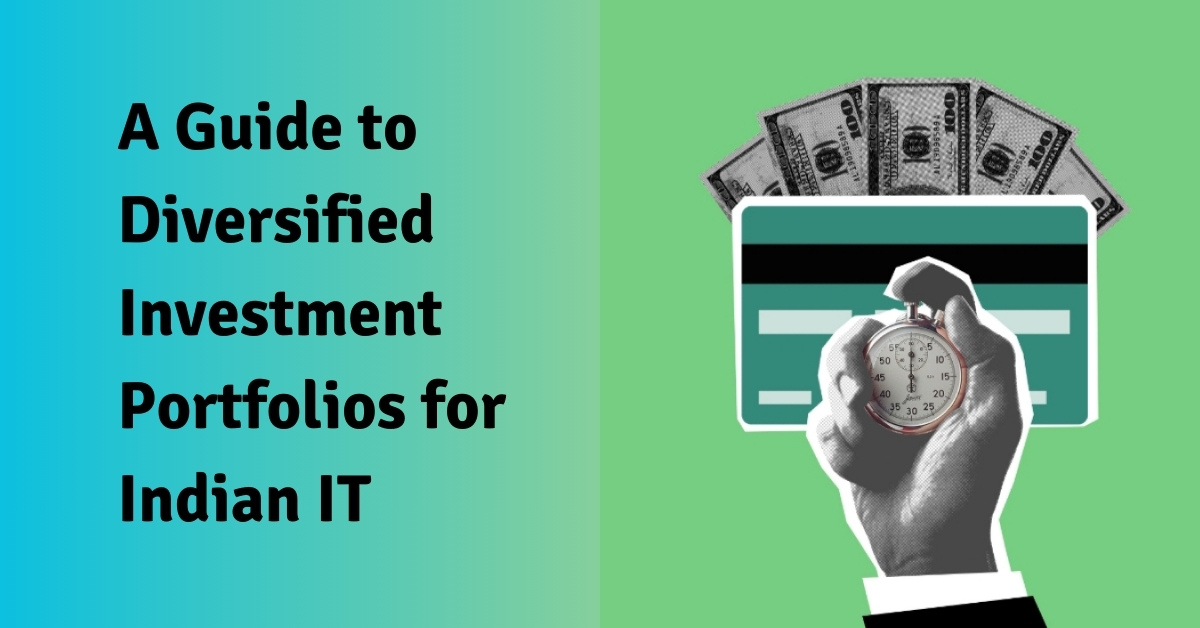A Guide to Diversified Investment Portfolios for Indian IT

The Indian IT sector pulsates with innovation and opportunity. It offers lucrative salaries and promising career paths, attracting a wave of talented professionals. However, with this financial security comes a crucial responsibility – managing your hard-earned income wisely. This guide delves into the concept of a diversified investment portfolio, empowering IT professionals in India to build a secure future and achieve their financial goals.
Why Diversify? The Power of Spreading Risk
Imagine placing all your eggs in one basket. If the basket falls, you lose everything. The same principle applies to your investments. Investing your entire savings in a single asset class, like stocks in a specific sector, exposes you to significant risk. Market fluctuations, economic downturns, or company-specific issues can drastically impact the value of your investments.
Here’s where diversification comes in:
- Reduced Risk: By spreading your investments across various asset classes, you minimize the impact of any single event on your overall portfolio. If one asset class performs poorly, others may perform well, mitigating losses and stabilizing your portfolio’s value.
- Improved Long-Term Returns: Diversification allows you to tap into the growth potential of different asset classes, potentially leading to higher returns over the long term. By combining assets with varying risk-return profiles, you can achieve a balance between risk mitigation and potential for growth.
- Peace of Mind: Knowing that your financial future is not dependent on the performance of a single asset class offers peace of mind. A diversified portfolio helps you weather market volatility and sleep soundly at night.
Asset Allocation: The Backbone of Diversification
The foundation of a diversified portfolio lies in asset allocation – the process of distributing your investment capital across various asset classes. The ideal asset allocation for you depends on several factors:
- Risk Tolerance: Are you comfortable with high-risk, high-reward investments, or do you prefer a more conservative approach? Understanding your risk tolerance is crucial for determining the appropriate asset allocation for your portfolio.
- Time Horizon: How far away are your financial goals? Investment timelines play a significant role. Generally, longer time horizons allow for a higher allocation to riskier assets with the potential for higher growth.
- Financial Goals: Are you saving for retirement, a down payment on a house, or a child’s education? Matching your asset allocation to your financial goals ensures your portfolio aligns with your long-term aspirations.
Exploring the Investment Landscape in India: A Mix of Options
The Indian financial market offers a diverse range of investment options for IT professionals:
- Equity Investments: Invest in stocks of Indian companies listed on the Bombay Stock Exchange (BSE) or the National Stock Exchange (NSE). Equity offers the potential for high returns but carries higher risk.
- Debt Instruments: Invest in fixed-income securities like government bonds, corporate bonds, or fixed deposits. These options offer relatively lower risk and stable returns.
- Mutual Funds: Invest in professionally managed mutual funds that pool funds from various investors and invest in a diversified basket of assets. This offers a convenient way to achieve diversification and minimize risk.
- Exchange-Traded Funds (ETFs): ETFs provide exposure to a basket of assets like stocks or bonds that track a specific index. ETFs offer low costs and instant diversification.
- Real Estate: Investing in real estate offers long-term appreciation potential and rental income. However, real estate requires a significant initial investment and ongoing management.
- Gold: Indians have a historical affinity for gold. It can be a good hedge against inflation, but its price can be volatile.
Building Your Portfolio: A Step-by-Step Guide
Here’s a roadmap to creating your diversified investment portfolio:
- Assess Your Risk Tolerance: Evaluate your comfort level with risk. Consider factors like your age, financial goals, and overall financial situation.
- Define Your Investment Time Horizon: When do you need the money you are investing? Short-term goals require a more conservative asset allocation, while long-term goals allow for more risk.
- Choose Your Asset Classes: Based on your risk tolerance and time horizon, decide how to allocate your investment capital across various asset classes.
- Select Investment Vehicles: Choose your preferred investment vehicles within each asset class. Research mutual funds, individual stocks, or ETFs based on your goals and risk profile.
- Start Investing Consistently: Don’t wait for the “perfect” time to start investing. Begin with a smaller amount and invest regularly, leveraging the power of rupee-cost averaging. This strategy helps you average out the cost of your investments over time.
- Rebalance Regularly: Review your portfolio periodically, at least once a year, to ensure your asset allocation remains aligned with your risk tolerance and evolving financial goals. Market fluctuations and life events might necessitate adjustments to your portfolio.
- Seek Professional Guidance: Consider consulting a registered investment advisor (RIA) for personalized advice. An RIA can help you develop a customized investment strategy based on your unique financial situation and goals.
Beyond Diversification: Additional Strategies for Indian IT Professionals
Building a diversified portfolio is a crucial step, but here are some additional tips for Indian IT professionals:
- Invest in Yourself: The most valuable asset you have is your skillset. Invest in continuous learning, upskilling, and professional development to enhance your career prospects and earning potential. This ultimately contributes to your long-term financial security.
- Embrace Tax-Saving Investments: Utilize tax-saving investment options like the Public Provident Fund (PPF), Employee Provident Fund (EPF), and Equity Linked Savings Scheme (ELSS) to benefit from tax deductions and potentially grow your wealth.
- Plan for Retirement Early: Don’t wait until later in your career to start planning for retirement. Starting early and contributing consistently to retirement plans allows you to leverage the power of compounding to accumulate a substantial corpus for your golden years.
- Maintain an Emergency Fund: Build an emergency fund to cover unexpected expenses like medical emergencies or job loss. An emergency fund provides financial security and prevents you from dipping into your investments to meet unforeseen needs.
- Manage Debt Wisely: High-interest debt can derail your financial goals. Focus on paying off high-interest debt like credit cards before aggressively investing. Consider consolidating debt into a lower-interest loan to simplify repayment.
Conclusion: Building a Secure Future, One Investment at a Time
The Indian IT sector offers immense career growth and financial potential. By creating a diversified investment portfolio, you can navigate market uncertainties and secure your financial future. Remember, building wealth is a marathon, not a sprint. Start investing early, prioritize a holistic approach that combines portfolio diversification with sound financial planning strategies, and consistently contribute towards your financial goals. With discipline and a long-term perspective, you can leverage your income from the dynamic IT sector to build a secure and prosperous future. So, take control of your finances, invest wisely, and watch your wealth grow!
FAQs
- What is diversification in investment?
– Diversification is the practice of spreading your investments across different asset classes to reduce risk and improve long-term returns. - Why is asset allocation important?
– Asset allocation is crucial because it helps balance risk and reward by distributing your investments according to your risk tolerance, time horizon, and financial goals. - What are the main asset classes I should consider?
– The main asset classes include equities, debt instruments, real estate, gold, and alternative investments like mutual funds and ETFs. - How often should I review my investment portfolio?
– It’s recommended to review your investment portfolio at least once a year or whenever there are significant changes in your financial goals or market conditions. - What is rupee-cost averaging?
– Rupee-cost averaging is an investment strategy where you invest a fixed amount regularly, regardless of market conditions, helping to average out the cost of your investments over time. - What are tax-saving investment options in India?
– Tax-saving investment options in India include the Public Provident Fund (PPF), Employee Provident Fund (EPF), Equity Linked Savings Scheme (ELSS), and certain fixed deposits and insurance products. - Should I invest in gold as part of my portfolio?
– Gold can be a good hedge against inflation and add diversification to your portfolio, but it should be balanced with other asset classes due to its volatility. - What is an emergency fund, and why is it important?
– An emergency fund is a reserve of money set aside to cover unexpected expenses or financial emergencies, providing financial security and preventing you from liquidating your investments prematurely. - How can I determine my risk tolerance?
– Assess your risk tolerance by considering factors like your age, income, financial goals, investment experience, and comfort with market fluctuations. - Is it necessary to consult a financial advisor for my investments?
– While not necessary, consulting a registered investment advisor can provide personalized guidance, helping you develop a tailored investment strategy and making informed decisions aligned with your financial goals.
Disclaimer: The information provided here is for educational and informational purposes only and should not be construed as financial, legal, or tax advice. Consult with a qualified professional before making any investment decisions. We do not accept any liability for errors or omissions in this information nor any direct, indirect, or consequential losses arising from its use.



